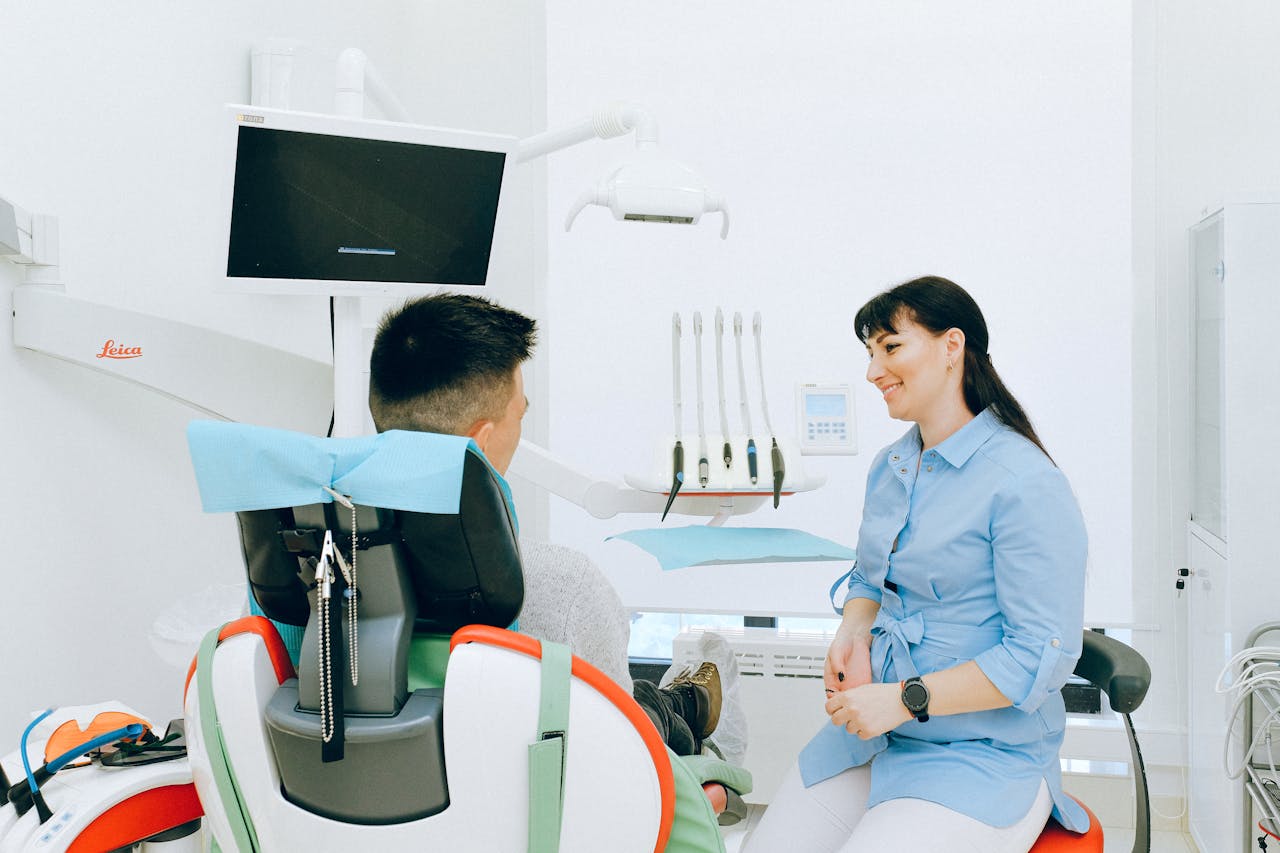Google Paid Ad Strategies For Dental Clinics In Kentucky

In Kentucky's competitive dental market, where 70% of patients search online before choosing a provider, Google Ads is not just an option—it's a necessity for growth. A well-structured campaign can place your practice at the top of search results the moment a potential patient in Louisville, Lexington, or a rural county searches for "dentist near me." However, every dollar spent on clicks is wasted if the resulting phone call goes unanswered.
That's where integrating your ad strategy with an AI receptionist for dental practices becomes critical, ensuring that every lead generated by your Google Ads is captured and converted into a booked appointment, 24/7.
Key Takeaways
- High Intent, High Stakes: Over 70% of patients research dentists online, and 88% of local Google searches result in a visit within 24 hours.
- Budget Realities: Expect to spend around $2,000-$3,600 monthly on Google Ads for a practice collecting $100,000, with CPCs in urban Kentucky reaching $10-$20.
- Conversion is King: Without proper tracking and a system to handle every call, your ad spend is wasted. An AI receptionist is key to capturing after-hours and overflow leads.
- Kentucky's Unique Market: With 42.4% of adults (in 2020) not visiting a dentist, messaging should emphasize accessibility, affordability, and insurance acceptance.
- Compliance is Crucial: Ensure your campaigns and tracking are HIPAA-compliant to avoid significant fines.
1. Understand Your Kentucky Market Landscape
Before writing a single ad, you must understand the market you’re in. Kentucky’s dental landscape is defined by a stark urban-rural divide. The majority of the state’s 2,546 dentists are concentrated in Jefferson (Louisville) and Fayette (Lexington) counties, creating a highly competitive market in these urban centers where you can expect to pay a premium for clicks. In contrast, five Kentucky counties have no practicing dentists at all, and many others are designated as dental shortage areas with a patient-to-provider ratio exceeding 1:5,000.
This duality demands a tailored strategy:
- In Louisville and Lexington: Focus on differentiation. Your ads should highlight unique services (e.g., dental implants, Invisalign, sedation dentistry), same-day emergency availability, or specific expertise to stand out.
- In Rural and Underserved Areas: Cast a wider geographic net in your targeting (30-50 mile radius) and emphasize your willingness to accept new patients, your insurance network (especially Medicaid, given Kentucky’s expansion), and flexible scheduling for patients who may travel long distances.
This market reality means your ad copy should address the specific concerns of your target audience. In a state that ranks 49th nationally on oral health indicators, a significant portion of your audience may be hesitant or have financial concerns. Messaging around “accepting new patients,” “flexible payment plans,” and “judgment-free care” can be highly effective.
2. Set Up Your Google Ads Account for Success
A strong foundation is essential. Start by creating a Google Ads account if you haven’t already. For multi-location practices or DSOs, use a Google Ads Manager Account (MCC) to oversee all your locations from a single dashboard, making it easier to allocate budgets and maintain brand consistency.
The most critical step after account creation is setting up conversion tracking. Google’s smart bidding algorithms need data to work. You must tell Google what a valuable action is for your practice. The primary conversions for a dental clinic are:
- Phone calls (tracked via Google’s call reporting or a call tracking provider)
- Form submissions (e.g., appointment requests, contact forms)
- Online appointment bookings
Without this data, Google can’t optimize your bids to get you more appointments—it will just get you more clicks, many of which may be worthless. Ensure your tracking is implemented correctly through Google Tag Manager and, critically, is HIPAA-compliant. This means your tracking should not capture any Protected Health Information (PHI) on confirmation pages that are behind a login.
3. Master the Art of Keyword Research for Kentucky
Your choice of keywords is the lifeblood of your campaign. You want to find the sweet spot between high search volume, manageable cost, and strong commercial intent. Use Google’s Keyword Planner to research terms, but be strategic.
Target high-intent, transactional keywords:
- "dentist in [City]" (e.g., "dentist in Bowling Green, KY")
- "emergency dentist [City]"
- "[Service] near me" (e.g., "teeth cleaning near me", "dental implants Louisville")
- "accepting new patients dentist"
Use negative keywords aggressively:
This is how you protect your budget. Add a comprehensive list of negatives to prevent your ads from showing for irrelevant searches. Common negatives include:
- "dental school"
- "dentist jobs"
- "dentist salary"
- "DIY"
- "at home"
- "free"
- "how to"
Kentucky-Specific Targeting: Don’t just use "dentist near me." Be specific. Target the names of your city, surrounding suburbs, and even county names if you serve a wide area. For example, a practice in Owensboro might target "Davies County dentist" or "dentist near Henderson, KY."
Expect an average cost-per-click (CPC) for general dentistry to be around $9.78, with costs in competitive urban Kentucky markets often being higher.
4. Build High-Converting Campaigns and Ad Groups
Structure is everything in Google Ads. A best practice is to create separate campaigns for your main service categories (e.g., General Dentistry, Cosmetic Dentistry, Emergency Dental). Within each campaign, build tightly themed ad groups.
For instance, your "Emergency Dental" campaign might have an ad group for "Toothache" and another for "Broken Tooth." Each ad group should contain:
- 5-20 tightly related keywords (e.g., "toothache relief," "emergency tooth pain," "dentist for toothache").
- 2-3 Responsive Search Ads (RSAs) built from 6-10 distinct headlines and 2-3 descriptions that speak directly to that theme.
Crucially, pair your online lead generation with 24/7 call answering and scheduling. Many of your highest-intent leads—especially from emergency searches—will call directly from your ad or landing page. If your front desk is closed or overwhelmed, that lead is gone forever. An AI receptionist ensures that a call at 11 PM from a patient with a severe toothache is answered, triaged, and scheduled, directly into your practice management software, turning a potential lost opportunity into a new patient.
5. Craft Compelling Ad Copy and Extensions
Your ad is your 3-second pitch. You must grab attention and compel the click. With Responsive Search Ads, Google mixes and matches your headlines and descriptions, so provide a variety of messages.
Headline and Description Formulas:
- Benefit + Location: "Same-Day Emergency Appointments | Louisville Dentist"
- Offer + Credibility: "Free Consultation on Dental Implants | 5-Star Rated Practice"
- Problem + Solution: "Suffering from a Toothache? | Immediate Relief in Lexington"
Ad Extensions are Non-Negotiable
They take up more real estate on the SERP and provide more reasons to click. Use them all:
- Sitelink Extensions: Link to key pages (e.g., "Book a Cleaning," "Emergency Services," "View Our Insurance").
- Call Extension: Your phone number, which is especially important for mobile users. This can increase CTR by an estimated 20%.
- Location Extension: Shows your address and a map.
- Callout Extensions: Highlight unique selling propositions ("Evening Hours Available," "Accepts Most Insurance," "New Patients Welcome").
Always ensure your ad copy is compliant with the Kentucky Board of Dentistry’s rules on professional advertising, avoiding any unsubstantiated claims or guarantees of specific outcomes.
6. Optimize Your Landing Pages for Conversions
There’s a direct line from your ad click to your conversion. Your landing page must deliver on the promise of your ad. If your ad is about "emergency dental in Covington," your landing page should be specifically about your emergency services, not your homepage.
A high-converting dental landing page includes:
- A clear, prominent headline that matches the ad.
- A visible phone number with a click-to-call button for mobile.
- An easy online booking form or a prominent call-to-action to call now.
- Trust signals like patient testimonials and professional credentials.
- Content that loads quickly (under 2 seconds on mobile).
Remember, 84% of patients use both online and offline sources for hospital research, and 44% of patients who find dentists via mobile search proceed to book an appointment. Your mobile experience is paramount. An AI receptionist integrated with your practice ensures that whether a patient calls from your landing page or fills out a web form, their inquiry is handled promptly and professionally, maximizing your conversion rate from your hard-earned ad traffic.
7. Track, Measure, and Calculate True ROI
Running Google Ads without measuring ROI is like flying blind. Your primary KPI is your cost-per-acquisition (CPA)—how much you spend to get one new patient appointment. To calculate this, you need to assign a value to your conversions.
Work with your team to determine your average patient lifetime value (LTV), or at least the average production value of a new patient’s first visit. Let’s say your average new patient’s first visit is worth $500. If your advertising goal is to acquire a new patient for less than $100, your target CPA is $100.
Utilize your analytics and ROI tracking for dental calls in conjunction with your Google Ads data to gain a comprehensive view. Google will tell you how many calls were tracked, but your internal system can tell you how many of those calls actually turned into scheduled and confirmed appointments, and their associated production value. This integration enables you to see your true marketing ROI and make data-driven decisions about where to allocate or reallocate your spend. Practices that combine smart bidding with proper conversion tracking see a significant increase in conversions at similar costs.
8. Leverage Kentucky-Specific Strategies and Timing
Your campaign should reflect the unique needs and rhythms of Kentucky life. Given the state’s below-average median household income and high percentage of residents who haven’t seen a dentist recently, your messaging should be empathetic and clear about costs and insurance.
Seasonal Campaigns are Key:
- December/January: Focus on "Use your dental benefits before they expire!" as patients rush to use their annual maximums.
- July/August: Target "Back-to-school dental checkups and cleanings."
- Spring: Promote cosmetic services like "Get your Kentucky Derby-ready smile" or "Graduation smile makeovers."
For practices in or near Lexington, be mindful of the UK basketball schedule or the Derby season in Louisville, as these can impact patient availability for appointments. An AI receptionist can help manage scheduling around these local events by clearly communicating your available slots to calling patients.
Frequently Asked Questions
Q: How much should a dental practice in Kentucky spend on Google Ads each month?
A: A general rule is to allocate 5-6% of your monthly collections to your total marketing budget, with a significant portion (40-60%) dedicated to Google Ads. For a practice collecting $100,000 a month, this typically translates to a Google Ads budget of $2,000-$3,600.
Q: What is the average cost per click for dental keywords in Kentucky?
A: The national average CPC for general dentistry is $9.78. In competitive urban markets like Louisville and Lexington, you can expect to pay between $6 and $7 per click, while rural areas may be lower.
Q: Do I need a dental marketing company to run Google Ads, or can I do it myself?
A: You can manage it yourself if you have the time and willingness to learn, but it has a steep learning curve. A qualified dental marketing agency can save you time and potentially money by avoiding common pitfalls. If you go the in-house route, start with the official Google Skillshop for free training.
Q: How do I track phone calls from Google Ads as conversions?
A: You can use Google’s built-in call reporting, which provides a temporary forwarding number on your ads. For more detailed tracking (like which keyword triggered the call), you may need a third-party call tracking provider that integrates with Google Ads. Ensure this setup is HIPAA-compliant.
Q: What are the best keywords to target for a dental practice in Louisville or Lexington?
A: Focus on high-intent, geo-modified keywords like "dentist in Louisville," "Lexington emergency dentist," "cosmetic dentist near me," or "[specific service] dentist Louisville." Avoid broad, non-transactional terms.









